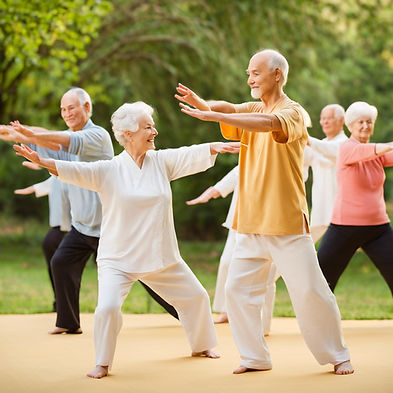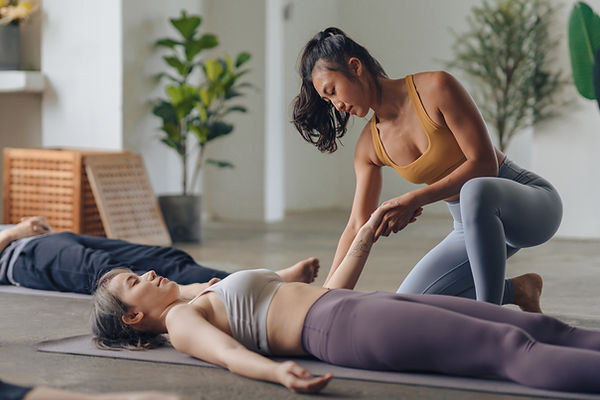pasaporte al mundo de las artes marciales



Benefits of Tai Chi for seniors
Tai chi is a form of exercise that began as a Chinese tradition. It’s based in martial arts, and involves slow movements and deep breaths. Tai chi has many physical and emotional benefits. Some of the benefits of tai chi include decreased anxiety and depression and improvements in cognitionTrusted Source. It may also help you manage symptoms of some chronic diseases, such as fibromyalgiaTrusted Source or chronic obstructive pulmonary disease (COPD)Trusted Source.
1. Reduces stress
One of the main benefits of tai chi is its ability to reduce stress and anxiety, though most evidence is anecdotal.
In 2018, one studyTrusted Source compared the effects of tai chi on stress-related anxiety to traditional exercise. The study included 50 participants. The researchers found that tai chi provided the same benefits for managing stress-related anxiety as exercise. Because tai chi also includes meditation and focused breathing, the researchers noted that tai chi may be superior to other forms of exercise for reducing stress and anxiety. However, a larger-scale study is needed.
Tai chi is very accessible and lower impact than many other forms of exercise. The researchers found it to be safe and inexpensive, so it may be a good option if you are otherwise healthy and experiencing stress-related anxiety.
2. Improves mood
Tai chi may help improve your mood if you are depressed or anxious. Preliminary research suggests that regularly practicing tai chi can reduce the symptoms of anxiety and depression. It’s believed that the slow, mindful breaths and movements have a positive effect on the nervous system and mood-regulating hormones. Further research is being done to establish a clear link between tai chi and improved mood.
3. Better sleep
Regularly practicing tai chi may help you to have more restful sleep.
One studyTrusted Source followed young adults with anxiety after they were prescribed two tai chi classes each week, for 10 weeks. Based on participant reporting, the individuals who practiced tai chi experienced significant improvements in their quality of sleep compared to those in the control group. This same group also experienced a decrease in their anxiety symptoms.
Tai chi can improve sleep for older adults, too. In a study published in 2016Trusted Source, researchers found that two months of twice-weekly tai chi classes was associated with better sleep in older adults with cognitive impairment.
4. Promotes weight loss
Regularly practicing tai chi can result in weight loss. One study tracked changes in weight in a group of adults practicing tai chi five times a week for 45 minutes. At the end of the 12 weeks, these adults lost a little over a pound without making any additional lifestyle changes.
5. Improves cognition in older adults
Tai chi may improve cognition in older adults with cognitive impairment. More specifically, tai chi may help improve memory and executive functioning skills like paying attention and carrying out complex tasks.
6. Reduces risk of falling in older adults
Tai chi can help improveTrusted Source balance and motor function, and reduce fear of falling in older adults. It can also reduce actual falls after 8 weeks of practice, and significantly reduce falls after 16 weeks of practice. Because fear of falling can reduce independence and quality of life, and falls can lead to serious complications, tai chi may offer the additional benefit of improving quality of life and general well-beingTrusted Source in older adults.
7. Improves fibromyalgia symptoms
Tai chi may compliment traditional methods for management of certain chronic diseases.
Results from a 2018 studyTrusted Source showed that a consistent tai chi practice can decrease the symptoms of fibromyalgia in some people. Participants in the study who practiced tai chi for 52 weeks exhibited greater improvements in their fibromyalgia-related symptoms when compared to participants practicing aerobics. Learn about other alternative treatments for fibromyalgia symptoms.
8. Improves COPD symptoms
Tai chi may improve some of the symptoms of chronic obstructive pulmonary disease (COPD). In one studyTrusted Source, people with COPD practiced tai chi for 12 weeks. At the end of the study, they have improvements in their ability to exercise and reported an overall improvement in their quality of life.
9. Improves balance and strength in people with Parkinson’s
In a randomized, controlled trial of 195 participants, regular practice of tai chi was found to decrease the number of falls in people with Parkinson’s disease. Tai chi can also help you to increase leg strength and overall balance.
10. Safe for people with coronary heart disease
Tai chi is a safe form of moderate exercise you can try if you have coronary heart disease. Following a cardiovascular event, regular tai chi practices may helpTrusted Source you:
-
increase physical activity
-
lose weight
-
improve your quality of life
11. Reduces pain from arthritis
In a small-scale 2010 study Trusted Source, 15 participants with rheumatoid arthritis (RA) practiced tai chi for 12 weeks. At the end of the study, the participants reported less pain and improved mobility and balance.
These classes are held Tuesdays at 3pm and Thursdays at 2pm and are 1 hour long.
Why not try a free class by filling out the form above.
PLEASE WEAR ENCLOSED SHOES OR SNEAKERS
NO CROCS OR OPEN SHOES PLEASE FOR SAFETY REASONS

Benefits of Restorative Yoga
Restorative yoga offers a range of benefits for both physical and mental well-being. These include:
Physical Benefits:
-
Improved circulation:
Deep breathing and relaxation promote better blood flow throughout the body, reducing inflammation and improving circulation.
-
Enhanced sleep quality:
The calming and relaxing nature of restorative yoga helps prepare the body for sleep and improves sleep duration and quality.
-
Improved flexibility and mobility:
Holding poses for extended periods allows muscles and connective tissues to relax and lengthen, leading to increased flexibility.
-
Reduced muscle tension and pain:
Restorative yoga focuses on gentle poses that support the body, reducing muscle strain and pain.
Mental and Emotional Benefits:
-
Stress reduction and anxiety relief:
The slow, supported poses and deep breathing encourage relaxation and reduce stress hormones, promoting a sense of calm.
-
Improved mood and well-being:
Restorative yoga fosters a sense of self-care and encourages mindfulness, leading to improved mood and overall well-being.
-
Enhanced focus and concentration:
The meditative aspects of restorative yoga help quiet the mind and improve focus and concentration.
-
Improved digestion:
Relaxation and reduced stress can positively impact the digestive system, reducing bloating and constipation.
Other Benefits:
-
Boosts the immune system:
Stress reduction and improved circulation contribute to a stronger immune system.
-
Promotes self-awareness and body connection:
Restorative yoga encourages introspection and mindfulness, deepening the connection between body and mind.
-
Improves balance and coordination:
Some restorative poses involve gentle movements that enhance balance and coordination.
It's important to note that restorative yoga is a gentle and accessible form of yoga that is suitable for people of all levels of experience and fitness. It can be a beneficial addition to any wellness routine, providing a relaxing and restorative experience. These classes are held Thursdays at 5:30pm and are 1 hour long.
Why not try a free class by filling out the form above or below.

“Yoga Conditioning”
Combines sequences that focus on building well-rounded strength and stability. Expect a variety of core work, standing poses, mat work, slow, quicker and jumping movements along with breathwork to support nervous system resilience & immune function. Clear out the cobwebs and leave you feeling physically strong and mentally centered.
Props: Blocks, strap, blanket or bolster
This class is held Tuesdays at 5:30pm. Why not try a free class by filling out the form below.
acupuncture
Click above image for information
What is Acupuncture
Acupuncture involves the insertion of very thin needles through your skin at strategic points on your body. A key component of traditional Chinese medicine, acupuncture is most commonly used to treat pain. Increasingly, it is being used for overall wellness, including stress management.
Traditional Chinese medicine explains acupuncture as a technique for balancing the flow of energy or life force — known as chi or qi (chee) — believed to flow through pathways (meridians) in your body. By inserting needles into specific points along these meridians, acupuncture practitioners believe that your energy flow will re-balance.
In contrast, many Western practitioners view the acupuncture points as places to stimulate nerves, muscles and connective tissue. Some believe that this stimulation boosts your body's natural painkillers.
Why it's done
Acupuncture is used mainly to relieve discomfort associated with a variety of diseases and conditions, including:
-
Chemotherapy-induced and postoperative nausea and vomiting.
-
Dental pain.
-
Fibromyalgia.
-
Headaches, including tension headaches and migraines.
-
Labor pain.
-
Lower back pain.
-
Neck pain.
-
Osteoarthritis.
-
Menstrual cramps.
-
Respiratory disorders, such as allergic rhinitis.
-
Tennis elbow
You can contact the Acupuncturist by clicking on either of the images above.
massage therapy

Massage therapy offers numerous benefits for both physical and mental health. Some of the key benefits include:
Physical Benefits:
-
Reduced stress on joints:
By relieving muscle tension, massage therapy can reduce stress on joints and improve their function.
-
Reduced muscle tension and pain:
Massage therapy helps to relax muscles, reduce inflammation, and improve blood flow to sore areas.
-
Increased flexibility and range of motion:
By stimulating and stretching muscles, massage therapy can improve flexibility and range of motion.
-
Improved circulation:
Massage therapy promotes blood flow throughout the body, which can help to reduce swelling and improve healing.
Mental and Emotional Benefits:
-
Relaxation and stress reduction:
Massage therapy releases endorphins, which have calming and pain-relieving effects.
-
Improved mood and well-being:
Massage therapy can promote feelings of relaxation, contentment, and overall well-being.
-
Reduced anxiety and depression:
Massage therapy can help to reduce stress hormones and improve mood regulation.
-
Enhanced sleep quality:
By promoting relaxation and reducing pain, massage therapy can improve sleep quality.
Emily Kukacka has been a licensed massage therapist since 2020.
Her focus in that time has centered on cultivating an approach to bodywork that combines the effectiveness of more direct therapeutic modalities, such as Trigger Point Therapy, Neuromuscular Release, Myofascial Stretch Therapy, and table-based Thai Massage, with more intuitive intentions. Pulling from her cumulative 12 years of dedicated effort to understand the mind-body connection through philosophy, yoga, meditation, the study of kinesiology and body mechanics, she strives to provide the most uniquely relevant session that she can for her clients within her capability, with the end goal always being to provide a tool for her clients to experience a deeper mind/body connection within themselves.
To make an appointment or for any questions Emily can be reached by clicking the button below




